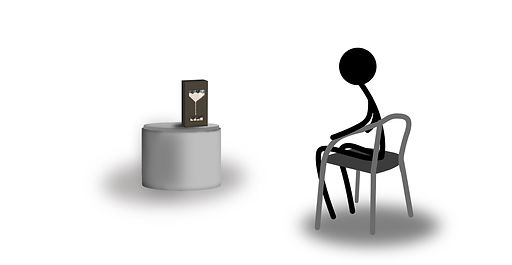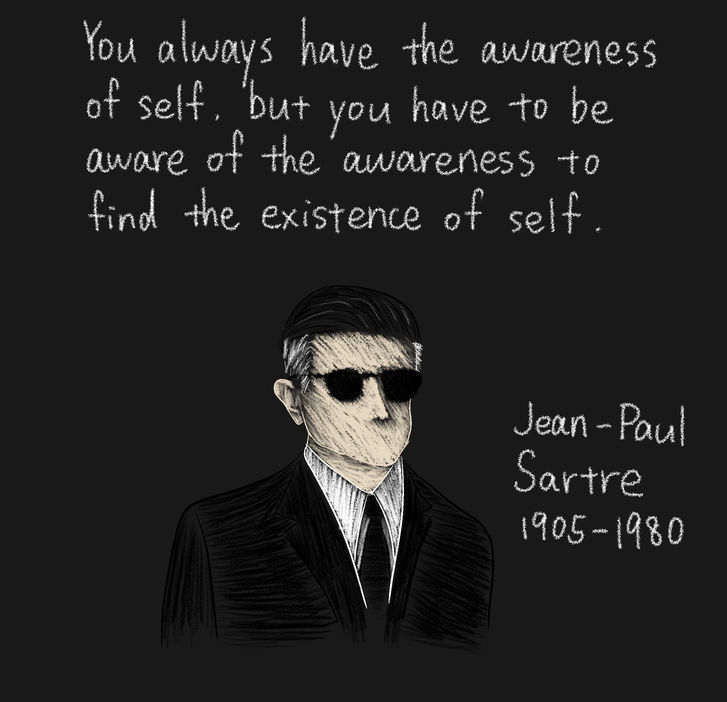.jpeg)
.jpeg)
Self in the Cage
This is a mini exhibition consisting of three interactive installations and a handbook. Through this project, I converted philosophic concepts to experience.
Background
Self-exploration is important, especially during this information explosion era. More people start to pursue their identities and beings to seek inner peace. While this topic has already been widely discussed in public forums, it has been already argued more in philosophical realm.



Philosophy
Context
René Descartes


In “Meditations on First Philosophy,” Descartes introduced his theory about why the self exists with an example of wax. After a piece of the wax is melted by fire, its physical characteristics change a lot, but people still can tell the melted wax is the original wax by “perceiving it through the mind alone” (Descartes, 22). Descartes argued that since there is no way to tell this fact from the physical details, people must get this idea from perception. Since the perception exists, there must be a self-perception. In this way, a self must exist because “I cannot perceive it thus without a human mind” (Descartes, 23).

Jean-Paul Sartre


In Sartre’s “the look” theory, people’s self will be emphasized and reminded when being gazed at. However, as Sartre argues, this reminded “self” is an object for the world and others.
David Hume


David Hume argues in his “A Treatise of Human Nature” that “there is no impression [of self] constant and invariable” (Hume, 251), so there is no perpetual self. Hume believes that the illusion of a perpetual self is because of the “identity of sameness” (Hume, 253), which is driven by “these three relations of resemblance, contiguity, and causation” (Hume, 260).


Philosophy
Conversation
Although these three philosophers did not live in the same generation, their different views about the self form a conversation arguing with each other while Descartes believed in the existence of the self, Sartre offered a way to observe the self, and Hume disagreed with both of them.
This "conversation" is valuable for self-exploration, but to read the texts of those arguments is not easy. Obscurity is one of the main obstacles for people to read the great work of a philosopher. As many philosophers only write for peers, their works are sometimes heavily based on many classical and their own previous theories. In this case, it may take a lot of time and hard work for a person to understand a philosophical argument. Among all the philosophical topics, “self” is one of the most abstract, or metaphysical, ones.

Design
Insight
To translate philosophical texts to interactive installations, I not only analyzed the arguments but also verified if some key points in the argument can be converted to visitors' actual feelings through surveys.






Space (The Cage)



It is made of PVC pipes and foam boards, offering a material context to highlight the space and establish a stronger connection between all the parts.
This huge cage is also a metaphor. In a larger context, the study of the self is usually not accessible to most people. The main purpose of the project is to offer an available window for everyone to join the conversation on this philosophical topic. As people enter the cage, they participate in a topic that is not usually publicly discussed.

To enter this space is like joining in the conversation between three great philosophers.

Installations
#1 The Wax (Descartes)



It is inspired by Rene Descartes's argument of wax in "Meditations on First Philosophy" which Descartes used to prove the existence of self. To represent Descartes's argument with this installation, I focus on the process of a piece of wax melting and refreezing.


A piece of wax can be put into the funnel and melted and kept hot by six heating pads controlled by a switch on the side and signaled by an LED light on the right corner. The working temperature of the heating pad in my circuit is about 70℃, and the wax I use is low-temperature wax that melts at around 50℃. In this case, the heat is enough to work but also safe for visitors. Then, the liquid wax will flow down to the mold of the word "self" and finally freeze in the word shape. The mold is attached to the surface by magnets which allows me to clean it up after each use.


The two sides and the backboard of the box are hollowed for heat dissipation, and a fan controlled by a switch in the box is attached on the left side to ensure the heat does not accumulate in the box when the installation works for a long time.
#2 The Look (Sartre)



It's a video mapping installation of a large movable eye. This eye is moving in real-time and projected on a convex 1.5-meter tall oval board with a wooden structure on the wall. The projection is shaped through MadMapper. The camera near the board is to help the eye to locate the position of people by employing a machine-learning program called PoseNet. In this way, people can see a large eye staring at them as they walk around.



As Sartre argues, this “self” is an object for the world and others. Therefore, instead of using the gaze of real people, I used a fake gaze to diminish objectification. In the previous user test, I found that the strength of the look is weaker when it is fake. Thus, I found a balance between the real and the fake. A movable eye is active enough for people to feel it as an alive creature. The large scale is compensation for the loss of strength.


In an interim user test with 10 people, I used a large blue human eye, but many people thought the gaze was not strong enough. Finally, I chose a crocodile eye in the final version. With the unique slim pupil, visitors can feel the gaze is more concentrated and powerful.



.jpeg)
#3 The Mirror (Hume)


The Mirror is a booth with a projected mirror. But the figure in the mirror will stay still and smile at the people after a few seconds.





By using the mirror as a context, I used resemblance but broke contiguity and causation with the sudden change of the figure. the sudden temporal overlapping of two selves can hurt people's faith in the existence of self, at least for a moment. They may rebuild their faith soon after, but the moment of shock is powerful.

Handbook
This handbook is a 12-panel comic book besides the cover and the back. By introducing the key philosophical ideas behind each piece, this handbook offers some background information to the audience. A conversational tone can help people to engage in the mini-exhibition further and trigger the audience to think about the relations between these pieces. The mirror with the words "SELF?" on the last page of the book is a mini version of The Mirror, which echoes with the Mirror and leaves more questions for the audience to think about.














